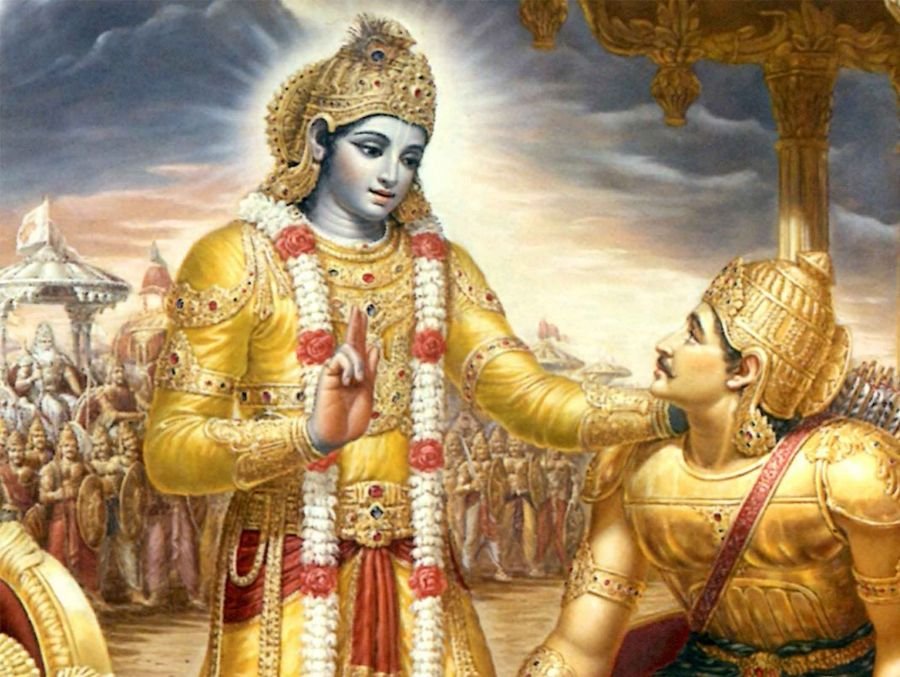(Image Courtesy Mahanidhiswami)
Always Remaining Absorbed in Divine Consciousness is Meditation
तानि सर्वाणि संयम्य युक्त आसीत मत्पर: |
वशे हि यस्येन्द्रियाणि तस्य प्रज्ञा प्रतिष्ठिता || 2.61||
tāni sarvāṇi sanyamya yukta āsīta mat-paraḥ
vaśhe hi yasyendriyāṇi tasya prajñā pratiṣhṭhitā|| 2.61||
Shloka Translation
BG – Ch. 2- Ver. 61:
They have perfect knowledge, who have subdued their senses, and have their minds absorbed in me at all times.
Explanation
Shree Krishna now reveals the correct engagement for the impulsive mind and senses, which is absorption in devotion to God, after stating that they must be controlled. There’s a mention of meditation here. Krishna always begins his meditation statements with the phrase “first regulate the senses.” you’ve restrained them all, he says, sit in meditation. You can’t meditate if your senses aren’t restrained. Meditation requires that the mind remain open. Because your senses are drawn to the sense things, your mind is racing all over the place.
In this verse, Krishna does not instruct us how to control our senses. He solely emphasizes the importance of maintaining sensory control. A person with self-control comes into contact with sense items while maintaining control over them. He explains in this verse that before you can meditate, you must first control your senses. Samyamya is a Sanskrit word that signifies “control” or “discipline.”
It is not forbidden to enjoy one’s senses. It is an inextricable part of human existence. However, if you allow it to operate without supervision, you will be destroyed. This idea is conveyed in Bhagavad Gita chariot symbolism. The five horses stand for the five senses. The mind holds the reins. The mind is the charioteer. When the charioteer is aware and skilled, the reins are tightened and the horses follow the charioteer’s instructions. As a result, you arrive at your goal. The reins are loose, the horses wander wherever they choose, and the chariot crashes if the charioteer lacks the necessary skills and is not aware.
Similarly, when your intellect is sufficiently strengthened and awake, your thoughts and senses will be correctly guided to your destination. When the brain is underdeveloped and the mind is not watchful, the senses are allowed to run wild and fall prey to their separate sense organs. As a result, you will fail both materially and spiritually. ‘A realized person has mastery over their senses.’ This is the first step on the path to spiritual growth.
The mind of a well-controlled individual is naturally calm and contemplative. It meets the requirements for meditation. The intellect focuses the mind on a single subject during meditation, preventing it from drifting into other thoughts. Even the final thought is gone when a practitioner meditates in this manner, leading to Realization.
Verse & what we can learn
Always keeping the mind absorbed in divine consciousness is the best way to have control over the senses.
How can we control our senses, Bhagavad Gita? What are the sense objects? How do you control your senses? What are the 5 working senses?
Lord Shri Krishan discussed the five senses, Bhagavad Gita
In the earlier verses, what they do and how they can distract one from the spiritual path here he shows a way to controlling the senses Bhagavad Gita that is “always be immersed in divine consciousness”. Otherwise, at any moment 5 working senses can drag us down any moment if not alert.
To always have one thought or to always be immersed in divine consciousness constant practice is required for the mind and meditation helps us in this process. There are various types of meditation like Buddhist meditation, heartfulness meditation, mindfulness meditation, meditation for stress, and each meditation benefits are countless. There are also numerous meditation techniques for beginners which help in practicing daily meditation so go ahead and start your journey towards a peaceful and balanced life.
In the next verse, Shri Krishna describes to Arjuna how a single thought/thought process, leads/gives rise to other things.
Let’s learn to live with “The Gita” via Meditation Affinity…
